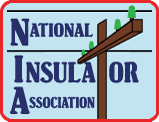
 |
Guidelines -- How To Submit New Entries To The WebsiteUnipart Insulator Submission |
Thanks to all the collectors who have assisted providing new additions to the website! This would not be possible without all your help!
We are very interested in any unipart pintype insulator that is not currently listed on the website as follows
Once you have identified an insulator to submit, here are some guidelines on the photos and additional data required:
A quality photograph is the most important factor in a contribution. This should not be difficult if some simple procedures are followed.
Background: Regardless of the color of the insulator a white background is the best option for contributions. To ensure consistency all pictures have the background cropped and made white. This can be as simple as using a piece of copy paper or poster board behind the insulator.
Lighting: Natural lighting is usually best, but flash photography can give acceptable results as well if the other guidelines are followed.
Insulator Placement: For consistency insulators should have their top groove perpendicular to the camera so you are looking through the groove. Insulators with special features (nosers, etc.) should have the feature to the right. Cross-top styles should be placed so the view sees two grooves.
Profile photo: To get the best results follow these guidelines. A digital camera with optical zoom is the best bet but modern cell phones can also do an adequate job. The goal is to have the photograph as close as possible to a profile drawing.

Taking the picture 3 to 5 feet back from the insulator will significantly reduce distortion. Closer views creates a fish eye affect that distorts the profile. If your camera has optical zoom, this can be used to make the insulator larger in the picture.
The camera should be centered on the insulator. Most collectors pictures are taken looking down on the insulator - this does not provide a consistent image and can hide features such as extended skirts.
The examples below show why the camera angle and distance are important. They also show the desired view and final cropped image to compare with a line drawing.
Too close - fish eye distortion |
Looking down - Inconsistent view |
Looking up - Inconsistent view |
Desired View! |
Final Drawing |
Profile Drawing |
Other documentation needed:
Submit all information to:
 Return
to the National Insulator Association page
Return
to the National Insulator Association page